Architectural Innovations for Biodiverse Urban Habitats
Green walls are amazing. They help 50 different species of plants and animals in just one square metre. This shows how new ways of building can turn cities into places full of life. They change dull cityscapes into lively and diverse environments.
Picture yourself walking through a city. Everywhere you look, there are tall buildings and busy roads. Then, you spot a wall covered in greenery. It’s filled with plants and wildlife. This scene is both beautiful and it acts as a home for local animals.
Key Takeaways
- Architectural innovations can create biodiverse urban habitats, supporting a wide range of plant and animal species.
- Green walls and green roofs are examples of how nature can be integrated into the built environment.
- Sustainable building materials and biophilic design principles can enhance the ecological value of urban spaces.
- Rewilding and habitat restoration initiatives can help reclaim natural spaces within cities.
- Policy and regulatory frameworks are crucial for incentivising the adoption of biodiversity-friendly practices in architecture and urban planning.
The Importance of Biodiversity in Urban Landscapes
Our cities are like vibrant paintings, made rich by Biodiverse Urban Habitats. Biodiversity is the wide range of life that thrives in these Urban Biodiversity sites. It is key in keeping Ecological Corridors healthy and providing vital Ecosystem Services.
Enhancing Ecosystem Services
Different plant and animal species boost essential Ecosystem Services in cities. They help clean the air and water, control pests, and pollinate plants. This is great for city residents’ health. Green Infrastructure and Wildlife Havens in cities blend nature with what people need, leading to Sustainable Cities.
Urban Wildlife Conservation
Although cities seem devoid of nature, they can offer Habitat Connectivity for various Urban Biodiversity. Using Nature-Based Solutions and Urban Rewilding, architects help urban wildlife. Their designs create vital Habitat Connectivity, supporting wildlife survival in cities.
Benefits of Biodiversity in Urban Areas
Adding Biodiverse Urban Habitats to city designs has many pluses. It makes urban spaces look better and helps people connect with nature through Biophilic Design. This improves city life a lot. Recognising the worth of Urban Biodiversity lets us build Wildlife Havens. These enrich our cities and make our communities more sustainable for the future.
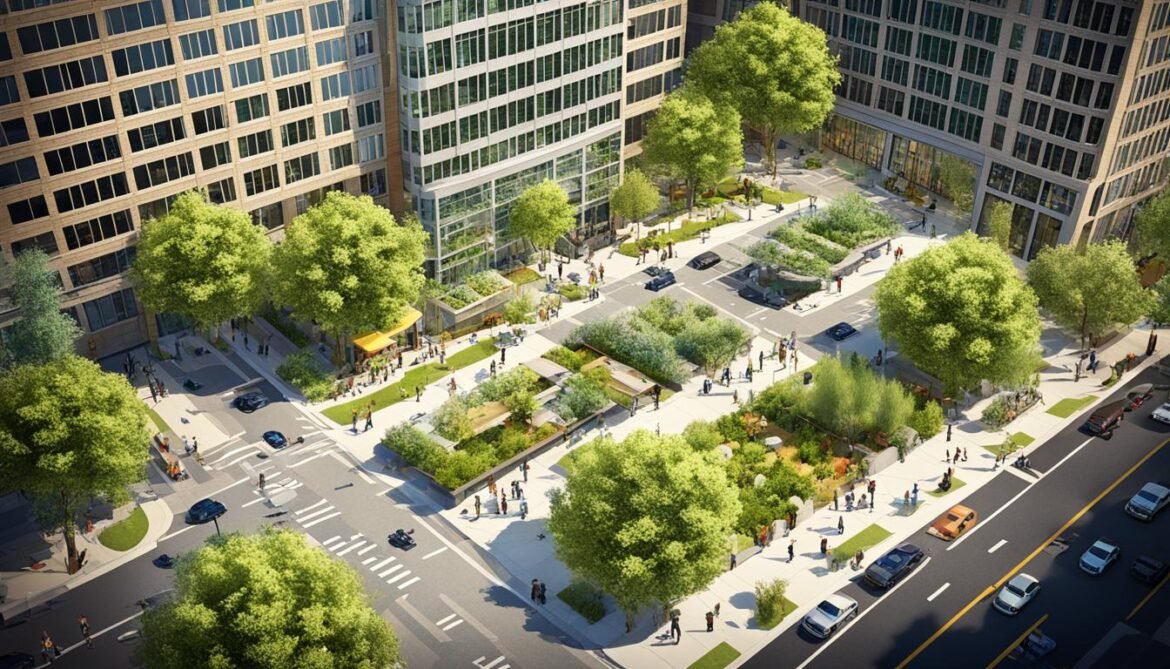
Green Walls as Biodiversity Supporting Habitats
Cities are working hard to be more green and full of life. Innovations like green walls are key. They turn urban areas into homes for many plants and animals. These walls are not just pretty; they are corridors and safe spaces for wildlife in cities.
Vertical Habitats for Urban Wildlife
Green walls turn dull walls into lively homes for plants and animals. They’re not just beautiful; they’re filled with life. Many plants, bugs, birds, and small mammals live on these walls. Green walls help different habitats connect. They also help keep city animals safe.
Improving Air Quality and Mitigating Climate Change
Green walls do more than just look nice. They help clean the air and fight climate change. Plants on these walls filter out pollution, soak up harmful gases, and give us fresh air. This all helps cities deal better with climate problems. Plus, green walls make cities cooler and better places to live.
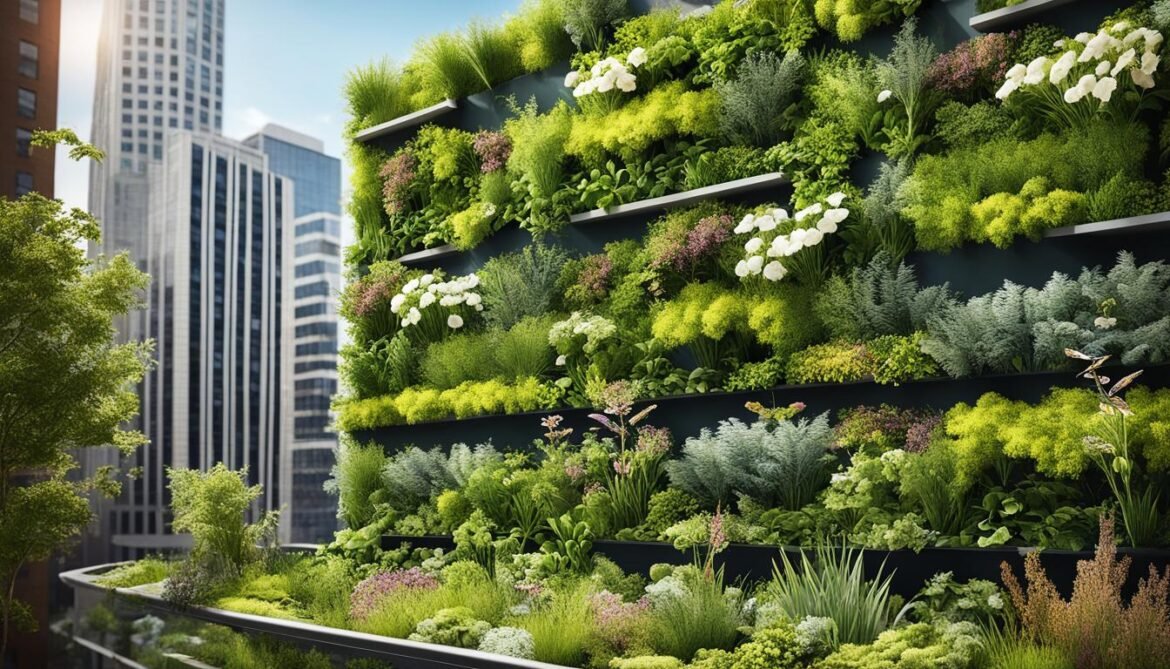
Green Roofs as Biodiversity Hotspots
Green roofs are more than just adding greenery to cities. They’re biodiversity hotspots. This means they enhance habitats for different species with their layers of soil substrate and plants. Green roofs are a unique place for many plant species to grow.
Elevated Ecosystems in the Concrete Jungle
Green roofs sit high on buildings, acting as urban biodiversity havens. They offer a living space for lots of different plants and animals. Birds, insects, and small creatures find homes, food, and safety in these green infrastructure spots. They provide what these creatures need in the concrete jungle.
Habitat Connectivity and Ecological Corridors
Linking green roofs with green walls and urban gardens creates ecological corridors. Architects do this to help species move through sustainable cities. This habitat connectivity is vital for urban biodiversity health. It allows for the mixing of genes and movement to new homes.
Biodiverse Urban Habitats
Cities are growing fast, and we must include nature in them. Architects and designers can make biodiverse urban habitats. These places help people and protect nature too.
Integrating Nature into Built Environments
They add green infrastructure like green walls and green roofs. This changes cities into wildlife havens. It helps birds and animals find homes while making the air cleaner.
It also fights climate change and helps cities be more sustainable.
Challenges and Opportunities
But, putting biodiversity in buildings is hard. There are many problems like city rules and finding money. Yet, these problems let us create new things and work together more.
Architects partner with ecologists and biologists. Together, they make buildings that help nature. This way, cities become places where both people and nature thrive.
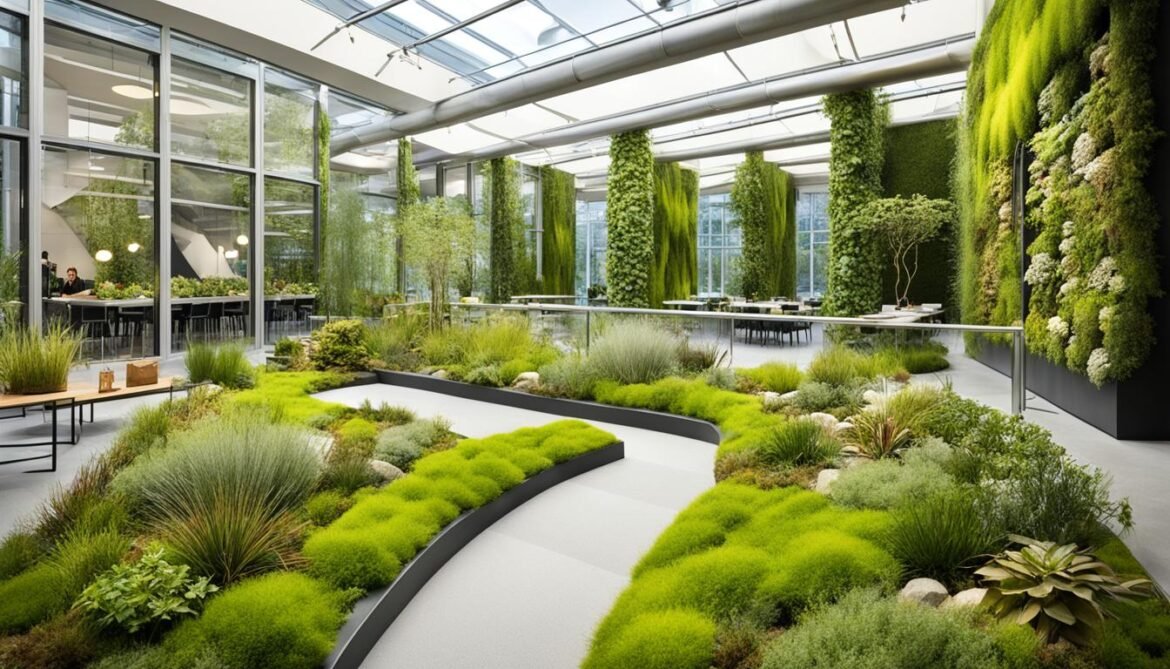
Sustainable Building Materials for Biodiversity Integration
Architects and designers work hard to make Biodiverse Urban Habitats. Picking the right building materials is key in this effort. The materials we use in construction can cut down on harm to the environment. They can also boost Urban Biodiversity. Choosing materials that are local, renewable, and safe helps cut down on damaging nature and pollution. This moves us towards Sustainable Cities and more eco-friendly places.
Locally Sourced and Renewable Materials
Using materials that are close by and can be replaced helps create Ecological Corridors and Habitat Connectivity. It lowers the pollution from moving materials long distances. Plus, it supports local communities and Wildlife Havens. Good options include timber, bamboo, and natural stone. These choices help keep natural resources available and encourage Urban Rewilding.
Non-Toxic and Low-Carbon Footprint
It’s also crucial to choose materials that are safe and low on carbon. Some synthetic materials like plastics and paints are bad for our health. They can also hurt Green Infrastructure. By going for materials that are healthier and kind to the planet, we make spaces better for people and Urban Biodiversity.
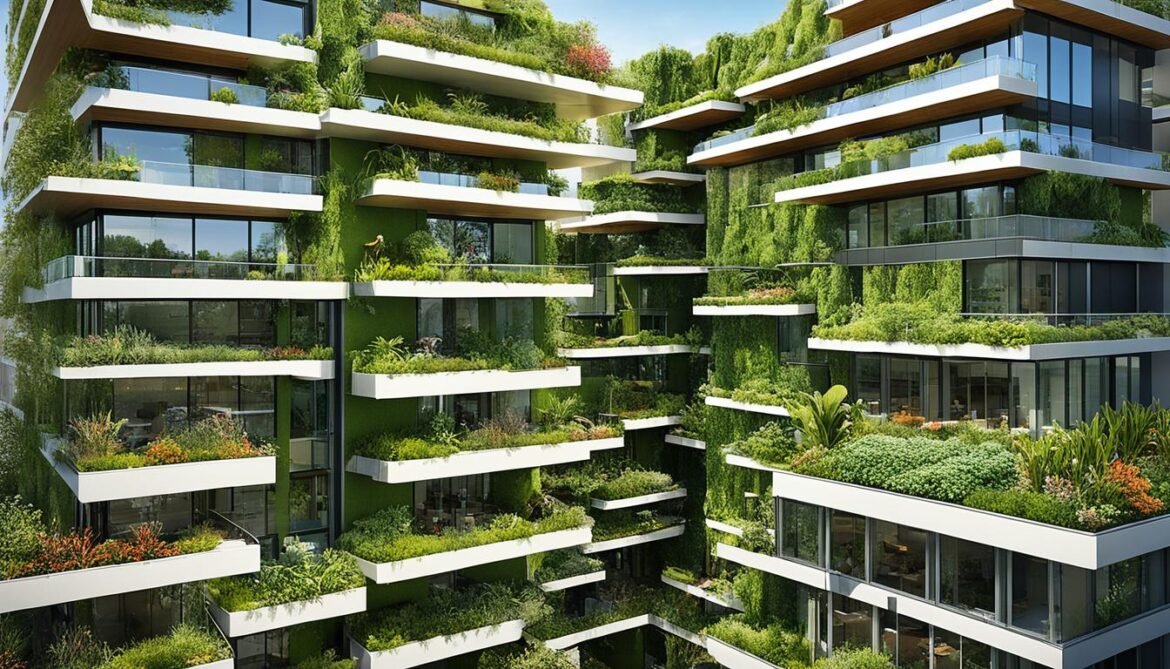
Designing Buildings as Habitat for Specific Species
Architects have a unique chance to help save urban biodiversity. They do this by designing buildings that are homes for certain creatures. They add things like nesting spots for birds. They also make homes for pollinators, such as bees and butterflies. This way, they make cities a better place for life.
Nesting Opportunities for Birds
Urban birds like swifts, swallows, and sparrows depend on buildings to nest. Architects create green infrastructure and wildlife havens for these birds. They add ledges, crevices, and cavities perfect for nesting. This helps keep bird populations strong in sustainable cities.
Habitats for Pollinators
Pollinators, like bees and butterflies, are key in biodiverse urban habitats. Architects design buildings with spaces that have lots of nectar-rich plants. They also make sure there are places they can shelter and nest. This supports these important creatures and helps the city grow more naturally.
Collaboration with Ecologists and Biologists
To create animal-friendly spaces in buildings, architects need to work with nature experts. This includes ecologists and biologists. They help architects learn what birds and insects need. Then, architects can design green spaces that really help animals live comfortably in sustainable cities.
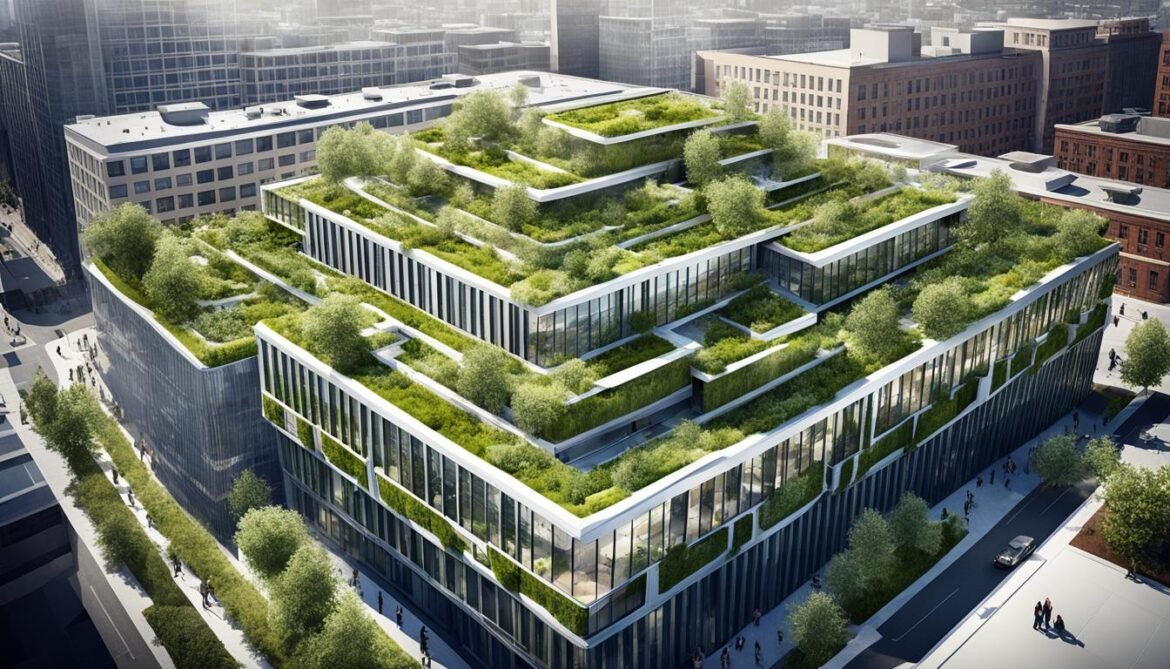
Architectural Innovations in Biophilic Design
Biophilic design is inspired by nature. It’s getting a lot of love in architecture. It helps make places better for plants and animals, and us, too. This idea knows we need nature in our lives. So, it brings bits of it right into our homes and workplaces.
Principles of Biophilic Design
Biophilic design says we should put nature’s touch in our buildings and cities. We do this by using natural stuff, making green spaces, and letting in lots of fresh air and light. These steps help us feel closer to nature, making our cities better for everyone and everything.
Health Benefits of Nature-Inspired Spaces
Loads of research shows how nature helps people feel good. Things like green walls and homes for wildlife can lower stress and make us think better. They also make our bodies and minds healthier. By adding these natural bits to our buildings, we help both the planet and people who live there.

By designing with nature in mind, we can make our cities healthier and happier. This way, we tackle big city problems while making places where both nature and people can thrive. It’s about creating spaces that are good for all living things. And doing so helps the earth and all who call it home.
Urban Rewilding and Habitat Restoration
People are talking more about rewilding as a key conservation method. It helps turn back the clock on habitat loss, species decline, and ecosystem damage. In the design world, rewilding means giving nature space to grow within cities. It aims to create diverse and healthy Biodiverse Urban Habitats in tightly packed urban areas.
Ecological Corridors and Wildlife Crossings
Today, architects and city planners are working on cool ideas to join up nature spots. These are Ecological Corridors that allow animals to move and mix. They’re adding things like green bridges and wildlife crossings to help different species travel safely. It’s all about making space for nature in our built-up areas.
Indigenous Perspectives and Traditional Ecological Knowledge
Getting wisdom from the people who’ve lived close to nature for centuries is a smart move. By working with these local experts, designers and architects get to know the land better. They learn not just about ecosystems but also about the people who once cared for these places. It helps bring unique, nature-friendly ideas to building and designing cities.
| Key Strategies for Urban Rewilding and Habitat Restoration | Benefits |
|---|---|
| Ecological Corridors and Wildlife Crossings | Facilitate species movement, migration, and gene flow; increase Habitat Connectivity |
| Incorporation of Indigenous Perspectives and Traditional Ecological Knowledge | Leverage community-based expertise, promote cultural diversity, and enhance Biodiverse Urban Habitats |
| Restoration of Native Habitats and Rewilding of Urban Spaces | Enhance Urban Biodiversity, provide Wildlife Havens, and promote Sustainable Cities |

Policy and Regulatory Frameworks
Bringing biodiversity into how we design buildings needs solid support from the law. Governments and those who make the rules are vital. They provide rules and rewards that push for green and nature-friendly building practices. Through these, they make sure that green spaces are used more, city habitats are fixed up, and that those who build choose greener options.
Incentives for Green Infrastructure
Leaders can offer reasons to include green spaces like walls and roofs more. For instance, they might give tax breaks, quicker ways to get permits, or money for certain projects. These actions help beat the money problems that stop more nature-friendly building choices.
Sustainable Urban Planning Initiatives
In addition to rewards, leaders can kick off big plans for sustainable living in cities. This can mean keeping and adding green areas, and making sure building projects match nature. They might tell builders to add more plants and protect the ones already there. By making these plans, leaders can really change how our cities look and feel for the better.
FAQ
What are the key benefits of incorporating biodiversity into urban design?
Introducing more variety of life into cities helps in many ways. It makes the air and water cleaner. It controls pests and enables plant pollination. This creates a better living environment for people as well as animals.
How can green walls support urban biodiversity?
Green walls grow plants up high, adding greenery vertically. They offer homes to various creatures, from plants to birds. These walls are known to attract and support a wide range of wildlife, thus promoting biodiversity in cities.
What role do green roofs play in promoting urban biodiversity?
Green roofs act as important spots for wildlife in densely populated areas. They are made of several layers where different plant species grow. These roofs offer a place for many plants to thrive and for animals to find food and shelter.
How can sustainable building materials contribute to urban biodiversity?
Choosing the right building materials can lessen harm to the environment. Local, natural, and safe materials help reduce pollution. This approach supports a healthier environment for all living things.
What design features can architects incorporate to support specific wildlife species in urban areas?
Architects can help wildlife by including special features in their buildings. They can add bird nests and habitats for bees and butterflies. This helps animals survive in the city.
How can biophilic design principles help integrate biodiversity into the built environment?
Biophilic design brings nature into our cities and buildings. It benefits both wildlife and people. It seeks to connect us with nature, enhancing our quality of life.
What is the role of urban rewilding in restoring biodiversity in cities?
Urban rewilding helps nature to bounce back in city areas. It fights against the loss of habitats and animal species. It gives us a chance to make our cities green and full of life again.
How can policymakers and governments support the integration of biodiversity into urban design?
Creating greener, wildlife-friendly cities needs good rules. Policymakers can encourage eco-friendly building practices. This helps make cities more liveable for both people and animals.
Source Links
- https://learn.constructive-voices.com/the-nature-of-architecture-integrating-biodiversity-into-design-philosophy/
- https://www.archdaily.com/1005791/re-wilding-in-architecture-concepts-applications-and-examples
- https://learn.constructive-voices.com/greener-pastures-architectural-interventions-to-promote-biodiversity/




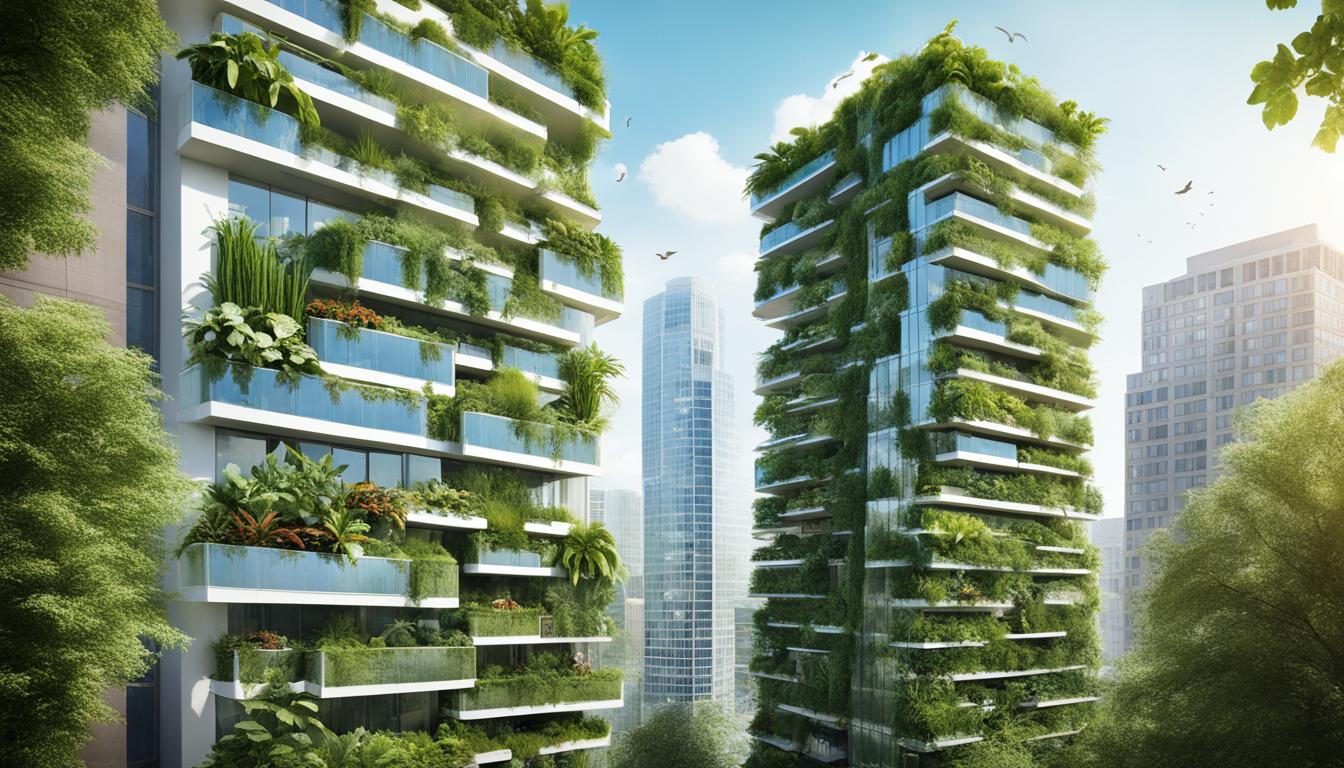




Rewilding Urban Spaces: The Role of Nature-Positive Architecture - Learn at Constructive Voices
5 months ago[…] https://constructive-voices.com/biodiverse-urban-habitats/ […]